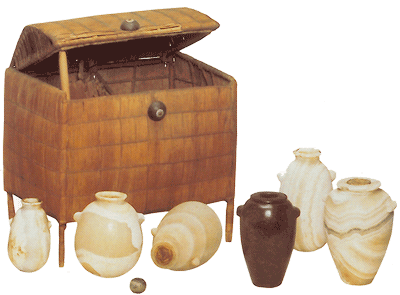| Clothing |
|
|
Make-up |
|
| Make-up
Egyptian women wore make-up just like women today. Men also wore eyeliner; but not just to look pretty. Paintings from the tomb of Queen Nefertari (above) show her wearing black eyeliner, but also rouge on her cheeks and her lips. |
A woman applying make-up, holding a mirror |
Eyeliner
At first eyeliner was green and made from malachite. After the time of the pyramids, the Egyptians switched to kohl, which is black like today. Kohl was made from galena, a lead-based stone. It was powdered, water was added, and it was applied with the fingers. In the Middle Kingdom the 'kohl pencil' was invented. Above you see a kohl bottle with its stick.
|
| Rouge and
Lipstick
Red ochre, a reddish-brown soil, was used in paintings, but also for make-up. As a powder it could be added to the cheeks, and it was mixed with oils and animal fats to make lipstick. The picture to the right shows some red ochre. |
|
Henna and
Tattoos
Henna, like today, was used to colour hair a reddish-brown. It was also sometimes put on nails, or even the palms or the soles of the feet. Tattoos were also quite common. Mummies of female dancers and musicians have been found with geometric patterns on their skin. |
| Why did both
men and women wear eyeliner?
Eyeliner made the eyes look bigger, and therefore more attractive. But it also protected the eyes from bright sunlight, and it helped protect the eyes from infection too. It was made from galena, a lead ore, however, which was poisonous. |
|
Storage
Ladies kept their cosmetics in cases like the one on the left. All sorts of jars were used to store make-up, ointments and perfume. The ones shown here are made of alabaster. |
 Tweezers in the Manchester Museum |
A fish-shaped dish for mixing make-up, at the Manchester Museum |
Sticks for applying kohl in the Manchester Museum |






